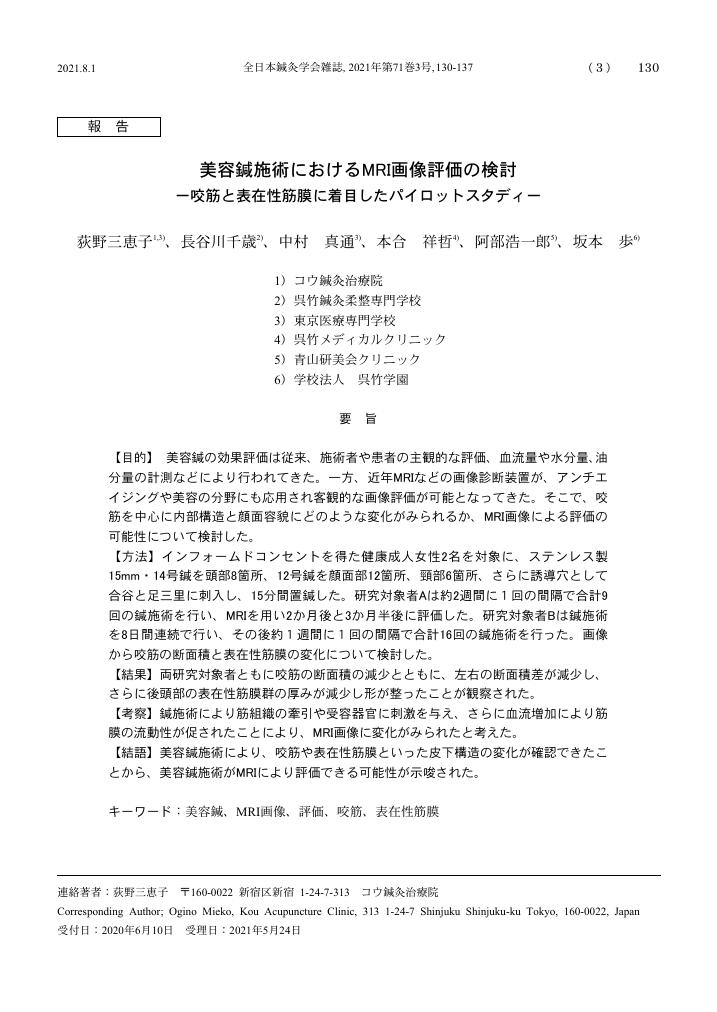31 0 0 0 OA 米国 NIH 在籍日本人研究者の現状について
- 著者
- 三浦 有紀子 阿部 浩一 今井 寛 第1調査研究グループ
- 出版者
- 科学技術政策研究所
- 雑誌
- 調査資料 (Research Material)
- 巻号頁・発行日
- vol.116,
2 0 0 0 OA 美容鍼施術におけるMRI画像評価の検討 ー咬筋と表在性筋膜に着目したパイロットスタディー
- 著者
- 荻野 三恵子 長谷川 千歳 中村 真通 本合 祥哲 阿部 浩一郎 坂本 歩
- 出版者
- 公益社団法人 全日本鍼灸学会
- 雑誌
- 全日本鍼灸学会雑誌 (ISSN:02859955)
- 巻号頁・発行日
- vol.71, no.3, pp.130-137, 2021 (Released:2021-12-01)
- 参考文献数
- 12
- 著者
- 阿部 浩一
- 出版者
- 公益財団法人史学会
- 雑誌
- 史學雜誌 (ISSN:00182478)
- 巻号頁・発行日
- vol.107, no.11, pp.1997-1998, 1998-11-20
- 著者
- 阿部 浩一
- 出版者
- 地方史研究協議会
- 雑誌
- 地方史研究 (ISSN:05777542)
- 巻号頁・発行日
- vol.71, no.6, pp.79-86, 2021-12
1 0 0 0 戦国大名領下の「蔵」の機能と展開
- 著者
- 阿部 浩一
- 出版者
- 公益財団法人史学会
- 雑誌
- 史學雜誌 (ISSN:00182478)
- 巻号頁・発行日
- vol.103, no.6, pp.1096-1120, 1221-1222, 1994-06-20
In this article, the author examines the relationship between feudal powers during Japan's Sengoku period (sengoku daimyo) and local society under their rule from the aspect of taxation, focussing on the function and actual operation of "kura" 蔵 (storehouses), which were the centers for the collection, inventory control and fiscal allocation of taxes. In the first chapter, the author offers the case of kura in the territory of the Gohojo 後北条 family in order to examine their fundamental role during the period. The Gohojo established kura at all of the castles in its territories, including the family's main residence, for covering its fiscal expenditures, particularly okuradashi 御蔵出, the salaries paid to its vassals. The management of kura was relegated to either an administrator/vassal (kura-bugyo 蔵奉行) or local deputies (daikan 代官). Next, the author focuses on how kura dealt with taxes in arrears. The most important function of local deputies was the collection of taxes and duties, to the extent that they were made responsible for the payment of all taxes, whether actually collected or not. In consideration of such a heavy burden, local deputies were allowed to take security in place of unpaid taxes or deal with arrears as unpaid loans and charge interest on them until they were remitted in full. Moreover, the Gohojo carried out normal lending activities on the local level using the rice and currency stored in their kura. In the second chapter, the author pursues the function of usury centering around kura, and discovers various forms, such as kuramoto 蔵本, kurakata 蔵方, senshu 銭主 and doso 土蔵. For example, kuramoto were borrowers protected by the Gohojo itself, the daimyo assuming responsibility for "loans" in the case of tax arrears. This indicates a position of privilege within the daimyo's sociopolitical structure. In chapter three, the author presents similar examples in the management of kura within the territories of the Kai-Takeda, Imagawa, Tokugawa, and Asai families. He also shows cases in which usurers were appointed to the position of daikan under exemptions from provisions in edicts cancelling debts (tokuseirei 徳政令). On the other hand, daikan were able to use security and interest accumulated in the collection of unpaid taxes for their own personal lending activities. It was in this way that kura under the Sengoku daimyo functioned as tax storehouses, fiscal organs and usurious lending institutions. In conclusion, the author reviews the role and significance of kura in premodern Japan, tracing the history of its lending functions back to ancient times, when it was a clearing house for agricultural promotion and reclamation (kanno 勧農) loans.
